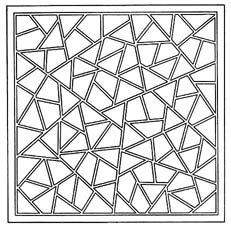 |
| Haldane Liew's Type II Shape Grammer |
Haldane Liew's Shape Grammers of Ice Ray Chinese Lattice Designs were helpful to my understanding shape grammer logic. Simple rules of translation, mirroring, rotation, addition, subtraction, division etc can quickly become complicated shape grammers by how they interact, the order they are called and which shapes they apply to. A design can be derived from simple stepwise rules, but the difficulty appears to be knowing what a shape is so as to determine which rule applys - in Haldane Liew's Type II example above the number of sides a polygon has determines how it will be divided. Shape grammers can be non-deterministic and allow for emergence because they can operate on any starting configuration of shapes.
There appears to be standard structures and terminology - see the summary definition on Wikipedia, and it appears there used to be a community - see the website shapegrammer.org, which has not been updated for 10 years (positively ancient!) but has an extensive bibliography of the seminal papers that defined this area of work.
Given that I am a novice coder, and that unfortunately most of the links to code examples are broken (they are old too), I have struggled to follow fully how shape grammars are structured. In the most basic terms there are rules which are expressed as LHS, if this shape, then transform to RHS, that shape, there are markers for identifying shapes and a method for reading those markers, and then there is a starting condition or input, and, although perhaps not always, end conditions.
I think I will have to experiment a little.
To finish, here is an example of what not to do! The Wright Mk II, in new Canberra suburb Crace. Although a bad premise, to recreate Frank Lloyd Wright Prairie Houses 100 years later and on the other side of the world from Chicago, if the designers had employed a shape grammar then at least the houses would be able to claim association with Wright with a little more integrity.
 |
| The Wright Mk II, Crace, Canberra |
I expect that the Crace promotional website with the article and brochure will not be maintained for prosperity, so I record below the article and above the brochure.
Frank Lloyd Wright's architectural vision arrives in Canberra
Plans have been released for a series of 12 special and uniquely designed houses at Crace that use The Chicago Group of world famous architects as their inspiration. As well as the great Frank Lloyd Wright, the design influences of Canberra's architectural visionary, Walter Burley Griffin, will also be incorporated into the homes that will be sited in the heart of the suburb's urban precinct.
Crace Project Director Ian Dawkins says the style of homes, designed by Melbourne-based architects dKO, are unique for Canberra and more likely to be seen on the streets of inner-city Melbourne or Sydney. "The idea is to create a style of living that is new for Canberra, but that also recognises and gives a nod to our city's heritage," Ian Dawkins says.
"While The Chicago Group practised in the 1900s, its style of architecture is internationally renowned for its vision and is highly sought after in the US, Australia and even China because of its clean, contemporary lines that make it super modern but also timeless."
No comments:
Post a Comment